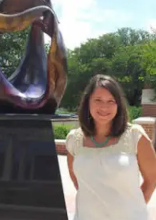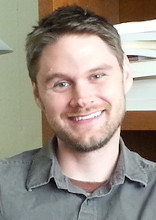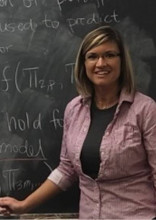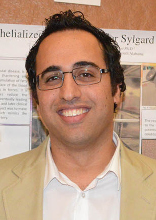Research and Scholarly Development Grant Program Awardees
The Research and Scholarly Development Grant (RSDG) Program has been created to provide tenure and non-tenure track faculty with funding of up to $25,000 to help build their research and scholarly careers. RSDG grants are intended to stimulate interactions across disciplines, departments, colleges, and programs. The funding is designed to facilitate preliminary data collection or planning efforts to assist in the development of competitive proposals that will attract external funding. Each RSDG proposal is required to demonstrate how funding for the project will lead directly to external funding requests. This USA internally-funded competition is sponsored by the Office of Research and Economic Development. Proposals are reviewed by faculty from Schools and Colleges across campus in three-member review panels. Review assignments are made to minimize conflict of interest and equalize the distribution of applications from each School/College.
2025 Awardees

Dr. George Clark
Assistant Professor, Department of Computer Science
School of Computing
"Detecting Man in the Middle Attacks in Robot Communications using a Non-linear Phase Space Algorithm"
Abstract: This research explores a novel approach to detect Man in the Middle cyberattacks
in interconnected robotic systems using a Nonlinear Phase Space Algorithm. Man in
the Middle attacks, which compromise communication integrity and confidentiality,
pose significant risks to autonomous robotics. Leveraging the Nonlinear Phase Space
Algorithm’s roots in chaos theory, the method analyzes anomalies in time-series data
to detect deviations in communication patterns. Unlike machine learning methods requiring
extensive training datasets, this approach dynamically identifies unforeseen attack
behaviors. The project employs ROS2 for inter-robot communication and involves four
stages: simulation environment setup with Jackal and Dingo robots, physical robot
integration and data collection, Man-in-the-Middle attack simulation, and
algorithm refinement. Expected outcomes include real-time attack detection with high
accuracy and reduced computational overhead, contributing to secure autonomous systems
and expanding opportunities for robotics research.

Dr. Lu Ding
Assistant Professor, Department of Counseling & Instructional Sciences
College of Education & Professional Studies
"Fostering AI Literacy through Collaborative Family Activities with Middle Schoolers"
Abstract: With the rapid advancement of Artificial Intelligence (AI), it has become integrated into nearly every aspect of our lives. Understanding how AI works and making informed judgments about AI-generated information, known as AI literacy, has become critical for both K-12 students and adults. However, research on teaching AI literacy in K-12 settings is still in its infancy, and studies on adult AI literacy are even scarcer. Families spend significant time together beyond school and work, and adults often rely on their children to learn about emerging topics. This proposed project is inspired by the PI’s previous work, which involved designing a board game to support AI literacy learning for parents and middle schoolers. It aims to explore other family leisure activities, similar to board games, that can foster collaborative AI literacy learning within families. The project will be conducted in two phases. In the first phase, a published AI literacy assessment by the PI will be used to measure AI literacy levels among caretakers and middle schoolers and to examine correlations between the two groups. The second phase will invite families to co-design leisure activities that promote collaborative AI literacy learning in family settings.

Dr. Laura Frost
Assistant Professor, Biology
College of Arts & Sciences
"Diversification at a glacial pace: understanding the relative contributions of fragmentation and hybridization on Pleistocene diversification in North American pondweeds (Potamogetonaceae)"
Abstract: The North American Coastal Plain (NACP) is the most recently identified of 36 global biodiversity hotspots. It is unique among hotspots in that it is the least topographically heterogeneous. As an overlooked and atypical hotspot, work is needed to (1) adequately document and describe plant species diversity and (2) understand the evolutionary patterns and processes that promoted the accumulation of biodiversity. Pleistocene glacial cycles isolated populations of species in climate refugia in the NACP, allowing for speciation in isolation (i.e., allopatric speciation), and brought species that did previously overlap into contact, allowing for hybrid speciation. While hybridization is an important evolutionary process for plant lineages, its contributions to diversification, the net result of speciation and extinction, are understudied. This project will fill knowledge gaps in biodiversity assessment and diversification dynamics through a phylogenomic study of pondweeds (Potamogetonaceae), a diverse and ecologically important submersed aquatic plant family with a center of diversity in North America. Aquatic plants are generally understudied and under-described; increases in aquatic plant diversity assessment stand to contribute the greatest potential knowledge gains in plant biodiversity and improve conservation efforts. Additionally, with similar numbers of described hybrids and discrete species (~100 each), pondweeds allow for robust statistical comparison of different mechanisms of speciation. This project will not only result in the likely discovery and description of new species but also be the first to examine the relative contributions of allopatric and hybrid speciation to the generation and maintenance of biodiversity in the NACP.

Dr. John Lanicci
Professor, Department of Earth Sciences
College of Arts & Sciences
"A Machine Learning Approach to Atmospheric Sounding Analysis"
Abstract: Atmospheric soundings, taken with instrumented weather balloons, are the most accurate method for observing fine-scale vertical structures associated with severe and tornado-producing thunderstorms. Forecasters have identified a number of sounding “signatures” indicative of potential severe weather. One of these signatures, known as a “capped sounding”, is a commonly observed profile that is often a precursor for severe and tornado-producing thunderstorms. There are several capped-sounding subtypes, and they are sometimes difficult to distinguish from one another, especially given the subjective nature of analysis. Such distinctions are often key to whether an environment will or will not produce severe weather. The goal of this study is to assess the feasibility of using objective classification models to identify capped soundings and their subtypes. We are unaware of any artificial intelligence/machine learning (AI/ML) studies to assist forecasters with critical sounding analysis. We propose using ML algorithms to analyze and classify several years of archived springtime atmospheric soundings over the U.S. southern Great Plains. The study will employ a classification method originally developed using FORTRAN-coded decision-logic subroutines, and will allow the ML algorithms to self-identify existing as well as yet-to-be defined subtypes. The desired result will be a catalog of capped-sounding subtypes that will provide forecasters with another tool for improving severe-weather forecasts for end users in emergency management, media, and the public. Our long-term goal is to apply for a multi-year extramural grant to continue the study by expanding it to additional regions and seasons, including the north-central Gulf Coast in winter.

Dr. Paula Levi
Assistant Professor, Adult Health Nursing
College of Nursing
"Low-Intensity Transcutaneous Auricular Vagus Nerve Stimulation and Nurse Stress: A Pilot Study"
Abstract: ICU nurses are repeatedly exposed to stress and trauma at work. This can cause dysregulation of the autonomic nervous system, resulting in adverse psychological changes, physiological changes, and consequences such as medication errors, decreased job satisfaction, and employee turnover. Our pilot study will explore efficacy, feasibility, and acceptability of a 2-week transauricular vagus nerve stimulation (taVNS) intervention among female ICU nurses to reduce stress and improve sleep. We will enroll 15 ICU nurse participants and conduct a pre-post study. Participants’ heart rate variability will be measured with a Fitbit device, to be worn 24/7 for study duration. Participants will utilize a taVNS device with low-intensity pulsed electrical currents to the vagus nerve using earbuds twice daily, for 10 minutes. Participants will log events they consider stressful and taVNS device use. Study surveys: the PTSD Checklist-5, Brief Trauma Questionnaire, Perceived Stress Scale 10-item, Peritraumatic Dissociative Experiences Questionnaire, Patient-Reported Outcomes Measurement Information System (PROMIS) Sleep Disturbance 4-item, PROMIS Emotional Distress-Depression 4-item, PROMIS Emotional Distress-Anxiety 4-item, and the Connor-Davidson Risk Scale 10-item. To assess feasibility, participants will complete an exit survey about acceptability, demand, implementation, and practicality. This research is a vital first step that will lead to a valuable contribution to science and consequently improve nurses’ health, healthcare delivery, and patient outcomes. Pilot data from this research, made possible by the Research & Scholarly Development Grant, will be vital for strengthening our team’s application for NIH National Center for Complementary and Integrative Health R34 funding.

Dr. Ryan Colquhoun
Assistant Professor, Department of Health, Kinesiology, & Sport
College of Education & Professional Studies
"Quantification of Protein Expression of a Novel Signaling Pathway in Human Skeletal Muscle"
Abstract: Skeletal muscle health is critical to the ability to perform activities of daily living and is positively associated with lower all-cause mortality. Thus, it is imperative to develop strategies to maintain skeletal muscle health to maintain functionality across the lifespan and offset the growing burden on the US healthcare system. Recent work utilizing animal models has provided evidence for improved skeletal muscle quality through a novel pathway (DGKζ) following resistance exercise. However, to date, there has been no direct evidence of DGKζ protein expression in human skeletal muscle. Therefore, the purpose of the proposed investigation is to examine the protein expression of the novel DGKζ pathway in human skeletal muscle tissue following a bout of acute resistance exercise. Secondarily, we aim to quantify the relationship between biological sex, skeletal muscle function, and skeletal muscle DGKζ protein expression. Data from this proposed investigation would provide proof-of-concept data for a plethora of future investigations, particularly larger scale, longitudinal investigations in vulnerable populations impacted most by poor skeletal muscle (i.e., aging). We believe this proposal would be a strong candidate for external funding from the National Institutes of Health, particularly this R21 NOSI posted by NIAMS. Further aiding in the competitiveness of this proposal for extramural funding is the inclusion of biological sex as a variable, particularly given NIH’s recent Policy on the Inclusion of Women in Clinical Research.

Dr. Lesley Gregoricka
Professor, Department of Sociology, Anthropology, & Social Work
College of Arts & Sciences
"Mobility and Shifting Bronze Age Social and Environmental Landscapes at the Al Ain
Oasis, UAE"
Abstract: As the most prominent features of Bronze Age cultural landscapes in the United Arab Emirates, monumental tombs have been used for decades to understand the transition from the Hafit (3200-2700 BCE) to Umm an-Nar (2700-2000 BCE) cultures. Nevertheless, human skeletons from both periods remain understudied because of poor bone preservation and extensive commingling. As a result, no investigations of the transformation of largely pastoral Hafit groups into more sedentary agropastoral communities using the bodies of those who experienced this transition firsthand have taken place. This study proposes a combination of traditional and innovative techniques to reveal (a) diverse strategies of movement in response to the adoption of oasis agriculture, and (b) intentional, locally driven adaptations to climate change. The hypothesized fluidity and flexibility of Arabian social structure may explain the resiliency of these prehistoric communities, and importantly may reveal how successfully smaller-scale societies negotiate internal and external change. Mobility will be assessed through the scientific analysis of human dental enamel from skeletal remains contained within both Hafit and Umm an-Nar tombs located at the Al Ain Oasis. Radiogenic strontium and stable oxygen isotope analyses of human teeth enable archaeologists to reconstruct the ways in which people moved across ancient landscapes, while stable carbon isotopes reveal dietary patterns associated with transformations in food acquisition such as the adoption of agriculture. These biogeochemical data will be recorded alongside indicators of skeletal pathology and trauma to more holistically explore the relationship between social organization, health, and responses to environmental stress.

Dr. Nigel Temple
Assistant Professor, Department of Civil, Coastal, & Environmental Engineering
College of Engineering
"Linear Optimization of Memristor-based Artificial Intelligence (AI) Hardware Design"
Abstract: Low-cost real time data sensing equipment and web-based data viewing applications are increasingly needed for several research and resource management needs. Researchers and resource managers often use government-funded analogues (e.g., NOAA’s Physical Oceanographic Real-Time System) to time data collection events, supplement models, or issue public warnings (e.g., small craft advisory). However, these applications are not easily adaptable and are limited due, in part, to the high costs associated with sensing and telemetry equipment. This limitation ultimately restrains research and resource management effectiveness and potential. The goals of the proposed project would simultaneously address these needs through the creation of a new low-cost and adaptable data sonde with telemetry capabilities and by establishing a data viewing platform for real-time data access. Both products would represent substantial advancements in coastal monitoring capabilities and would expand the University’s presence and authority in rapidly emerging technologies and approaches. This project will also enhance interdisciplinary research collaborations between PI Temple and Drs. Webb and Patch (CCEE), and Drs. Scyphers and Alemu (SOMES) – all of which have projects that would immediately benefit from low-cost sonde and network capabilities. Project deliverables could be completed in one year and would include the creation and testing of a low-cost data sonde and a framework for a web-based data viewing platform for environmental sensing data. Both products are scalable, easily augmented, and could be leveraged in several future funding opportunities.

Dr. Lisa Turner
Professor, Department of Psychology
College of Arts & Sciences
"Raising Resilient Families: PCIT and CBT an integrative approach"
Abstract: Externalizing behavior problems (EBP), including attention-deficit/hyperactivity disorder (ADHD), are the most common source of mental health referrals in early childhood, occurring in 10-25% of preschoolers. ADHD results in an estimated annual cost of $42 billion in the U.S. Parents of children with ADHD are at a substantially elevated risk for stress and anxiety, which is associated with elevated rates of child EBP, negative parenting behaviors, and poor treatment adherence. Parent-Child Interaction Therapy (PCIT) is an evidence-based behavioral parent training (BPT) program for EBP. PCIT has demonstrated positive effects on EBP, although the impact of parental anxiety on the efficacy of PCIT is yet unknown. Recent work has demonstrated substantial improvements in school-age children with ADHD, by integrating Cognitive Behavior Therapy (CBT) for parental depression with BPT. However, no study to date has examined the effectiveness of such an intervention with parents of younger children or parents experiencing high levels of stress/anxiety. For the present study, a sample of 46 families with children (ages 3-6yr) at-risk/diagnosed with a EBP will be randomly assigned to receive: (a) ten weeks of PCIT or (b) ten weeks of PCIT+CBT (for parental anxiety). The primary aim of this study is to examine the feasibility, tolerability, acceptability, and effectiveness of CBT+PCIT within an outpatient setting. This data will serve as pilot data for a resubmission to NIMH in the form of an R01 (anticipated submission June 2025).

Dr. Erica Ahlich
Assistant Professor, Department of Psychology
College of Arts & Sciences
"Redefining ‘Emotional Eating’ and Characterizing Individual Heterogeneity: An Ecological Momentary Assessment Study with Person-Specific Modeling"
Abstract: Emotional eating is a topic of clinical importance, with links to weight regulation and wellness. Yet, paradoxically, scores on emotional eating questionnaires are only weakly associated with eating behavior measured in the laboratory and in naturalistic studies. This inconsistency may be the result of ambiguity in the conceptualization and measurement of the “emotional eating” construct. Despite issues with construct clarity, emotional eating continues to be a frequently discussed treatment target within behavioral obesity treatment programs, bariatric surgery centers, and eating disorder treatment programs. Yet, without fully understanding what “emotional eating” is, it is difficult to establish when treatment would be warranted, how to effectively intervene, and how best to measure improvement. Combining innovative methods with advanced statistical approaches, the proposed project seeks to create a more complete framework for understanding emotional eating. Ecological momentary assessment (i.e., repeated, real-time data collection in an individual's normal environment) will be used to provide an ecologically valid assessment of emotional eating behaviors and their antecedents and sequelae. In addition, an advanced statistical technique—dynamic p- technique—will allow for individual-level analysis, resulting in person-specific profiles of the emotions and eating behaviors thought to underly emotional eating. A small proof-of-concept study conducted by this team suggested that this is a promising and feasible approach for better characterizing emotional eating, but additional research is needed with a larger sample to draw definitive conclusions from this idiographic approach.

Dr. Terry Ravine
Associate Professor, Department of Biomedical Sciences
Pat Capps Covey College of Allied Health Professions
"Development and Testing of Novel Antimicrobial Boronium Compounds"
Abstract: Novel boronium compounds developed at the University of South Alabama have shown excellent antimicrobial activity against a number of harmful bacteria, fungi, and viruses when compared to a commercial disinfectant containing quaternary ammonium compounds (QACs). Initial success supports further antimicrobial testing of current boronium compounds and the development of new variant boronium compounds for two likely applications. First, as a replacement for QACs in commercial disinfectants and antiseptics. Second, as a broad-spectrum drug to control antibiotic-resistant (AR) strains of bacteria. Currently, QACs or simply quats are in widespread use across several industries. They represent a primary source of commercial disinfectant for decontaminating soiled surfaces harboring harmful microorganisms. However, QACs have inherent health/environmental hazards and demonstrate increased bacterial resistance. QACs are known to be toxic to humans/animals and eventually make their way into the environment. Consequently, disinfectant manufacturers are actively seeking alternatives to QAC that are just as effective at controlling harmful microbes but with less risk to both human health and the environment. In this regard, a lack of safety data has been a major barrier in promoting boronium compounds as a safe and effective alternative to QACs. Three major corporations had expressed initial interest in the boronium compounds. A lack of safety data prevented further conversation. Consequently, biosafety testing is needed to determine suitability of boronium compound for human use along with its environmental impact. This would include both cytotoxicity and degradation testing. Cytotoxicity testing determines if a chemical substance is toxic to human cells. Degradation testing determines if a chemical substance released into the environment is broken down into smaller nontoxic molecules. Both types of testing are considered essential in attracting a suitable commercial partner for further boronium compound development. The scope of work outlined in this proposal is two-fold. First, producing more variant boronium compounds with decreased toxicity but increased antimicrobial effectiveness for subsequent biosafety testing. Second, performing additional antimicrobial testing using antibiotic-resistant (AR) bacteria and rhinovirus, a non-enveloped virus responsible for the common cold. Success in either endeavor would represent an important advancement in the control of infectious microorganisms. Success in both activities would result in a new class of antimicrobial compounds for use as disinfectants and antibiotics.

Dr. Jinhui Wang
Associate Professor, Department of Electrical and Computer Engineering
College of Engineering
"Linear Optimization of Memristor-based Artificial Intelligence (AI) Hardware Design"
Abstract: AI (Artificial Intelligence) technology is transforming the human daily life. Recently, memristor-based AI systems have drawn lots of attention to perform complex deep learning computation faster, more power-efficiency, and on a smaller footprint. Unfortunately, memristors are not reliable and their inherent nonlinearity characteristics cause the accuracy degradation in learning systems. In this project, 1) a new linear optimization (LO) algorithm is proposed to upgrade AI systems and heighten inference accuracy, and 2) AI hardware is simulated and evaluated by two popular tools - NeuroSim and MNSIM. It is expected that this research will demonstrate the ad- vantages of memristor-based AI hardware with high performance, contribute to avoid deviation between software and hardware in AI systems, and layout the foundation of a new and promising direction for both academic research and industrial development.

Dr. Shenghua Wu
Assistant Professor, Department of Civil, Coastal, & Environmental Engineering
College of Engineering
"Exploration of A Sustainable Asphalt Pavement Containing Recycled Plastics"
Abstract: Waste plastic has become a long-lasting and dire problem that threatens the environment and public health. The plastic recycling rate in the United States is significantly lower than that in other developed countries. Landfill is not the final sink of waste plastics, but a potential source of leaching microplastics that contaminate the drinking water. The need to seek alternatives for the use of waste plastics has become more urgent in recent years as China has banned the import of waste plastics, followed by India. This project is aimed at exploring an effective strategy to deal with large quantities of accumulatively stockpiled waste plastics, repurposing post- consumer recycled (PCR) plastics into various types and stabilizing them into an asphalt pavement surface layer. The objectives of this pilot study include (1) designing a recycling process to shred and repurpose PCR plastics into various forms (pellet, fiber, and powder), (2) evaluating the physical properties of various repurposed PCR plastics; (3) Designing the asphalt mixtures that are incorporated with the shredded PCR plastics and assessing their mechanical properties and performance characteristics. If the use of local waste plastic is proven to be feasible for asphalt pavement in southern Alabama, this project will open tremendous opportunities to large- quantity conversion and use of waste solids, saving significant amount of raw construction materials, and reducing environmental impacts and energy consumption. This project will also facilitate the collaboration among recycling centers, the solid waste industry, and end-product users such as construction contractors, state agencies, and stakeholders.

Dr. Kim Zlomke
Professor, Department of Psychology
College of Arts & Sciences
"Supporting autistic college students with PEERS©-Campus: Impact on social skills, social engagement, and campus belongingness"
Abstract: Many autistic young adults are intellectually capable of post-secondary education (PSE), although the social challenges that are diagnostic of autism often impact success in PSE and employment. PSE is critical for autistic individuals, as those who receive some level of PSE are more likely to find gainful employment successfully. Further, access and utilization of support services within PSE are predictive of post-secondary success regarding retention, satisfaction, and graduation. Universities offer academic accommodations to support academic success, yet rarely provide support to address critical social competencies and engagement. The Program for the Education and Enrichment of Relationship Skills (PEERS©) for Young Adults (PEERS-YA) is the first evidence-based, manualized group intervention for autistic young adults, and has empirical support for improving social competence and decreasing social anxiety in community-based young adults with ASD. Research on PEERS© within a PSE setting and in the utilization of peer mentors will provide evidence for its effectiveness and benefit for autistic students in a campus-linked program. The primary aim of the proposed project is to utilize a mixed-methods approach to gather quantitative data on the feasibility, acceptability, and effectiveness of a PEERS©-Campus program that includes peer social coaches as well as qualitative methods to gain a clearer understanding of participants' experiences and benefits. Aim 1: To assess the feasibility and acceptability of PEERS©-Campus through observational, quantitative, and qualitative methods. Aim 2: To examine the effectiveness of PEERS©-Campus on social skills and anxiety, loneliness, and campus belonging with quantitative analyses. Aim 3: To understand the social networks of autistic college students from their own perspectives before and after participating in PEERS©-Campus through social network analysis (SNA) methodology.

Dr. Mohamed Shaban
Assistant Professor, Department of Electrical and Computer Engineering
College of Engineering
"A Novel Fully Automated Detection Framework for Oil Spills in Synthetic Aperture Radar Images"
Abstract: Oil spills released into seawater cause serious harm to the marine environments. Prompt removal of the spills is crucial to prevent the spread of the oil over a large area and to limit the anticipated damage. The most common approach to identify oil spills is to transmit electromagnetic waves using airborne or spaceborne Synthetic Aperture Radar (SAR), measure the strength of the backscattered signal and generate visual representation of the signals. Both oil spills and “oil look-alikes” such as grease ice (i.e., a thin layer of ice crystals clumped together) and low wind speed areas have the same dark appearance as well as representing a small percentage of the images. This limits the use of fully automated techniques based upon deep-learning to identify the oil in images as the generated models are biased and not sufficiently trained on samples related to oil spills and look-alike groups. In this project, the PI will exploit the sparse presence of oil spills in SAR images by introducing a fully automated approach that will allow the identification of spills and differentiation from look-alikes with improved accuracy, recall and precision with respect to the-state-of-the-art fully automated methods. This work will provide an open-source fully automated tool that can be further developed for commercial use by oil companies initiating rescue plans for oil spill incidents. In addition, this will serve as a preliminary study for a proposal to be submitted to the NSF RII Track 4 Research Fellows Program that will aim at introducing a deep-learning technology that is capable of identifying underrepresented targets in high resolution images (e.g., nuclei in pathology images, micro-plastics in hyperspectral images) with high performance.

Dr. Jason Strickland
Assistant Professor, Department of Biology
College of Arts & Sciences
"A Ticking Time Bomb: Testing how viral infection modifies salivary gland gene expression in an invasive tick during feeding"
Abstract: Globally, ticks are the most consequential disease vector and are capable of spreading more pathogen species and greater pathogen diversity (viruses, bacteria, and parasites) than any other arthropod group. Ticks transmit pathogens during blood feeding via "saliva-assisted transmission" (SAT), whereby tick saliva proteins facilitate pathogen transmission from the tick vector to the mammalian host (e.g., people) at the bite site. SAT has been documented for viruses, but the specific proteins that facilitate viral transmission are unknown, making this an NIH priority. Identifying the proteins involved in SAT would facilitate development of vaccines that impair tick feeding and virus transmission, as has been done for Lyme Disease bacteria. We will use the invasive Asian Longhorned Tick, Haemaphysalis longicornis, as our tick vector. H. longicornis was first found in the U.S. in 2017, is now established in 17 states, and is expected to expand its distribution to much of North America because it reproduces asexually and can live in habitats with variable climates. Although this tick originates from Asia, it is already documented to transmit pathogens only found in the U.S., including Deer Tick Virus (DTV). We will use next-generation sequencing and bioinformatics to test for differential gene expression among four tick treatments (control, media-injected control, virus-injected, naturally virus infected) across three tick feeding time points (unfed, 6hrs, 24hrs). Our 12 treatment/time combinations will have eight ticks each for 96 total salivary glands sequenced. Using the H. longicornis reference genome and differential expression analyses, we will generate a list of SAT candidates that will be presented and published by the coPIs/students and serve as data for an NIH grant submission.

Dr. Daniela Touma
Assistant Professor, Department of Electrical and Computer Engineering
College of Engineering
"Machine Learning Models to enhance Energy Management Systems in Microgrids"
Abstract: The U.S. Government has invested heavily in the use of renewable energy (RE) as power sources for consumer households. Residential power consumers are encouraged to install RE generators in their houses so they are able to provide power to the utility grid when their power generation is higher than their consumption, thus becoming “prosumers” with Microgrids. These self-sufficient localized Microgrids represent the future of power systems but they face many challenges. Renewable energy depends on weather conditions, and residential load depends on human behavior. Both residential load and source are unpredictable and together they compose the residential net load. Artificial Intelligence (AI) algorithms are powerful tools to forecast complex properties and have been extensively researched for applications in several areas of Power Systems. The proposed work will transform the next generation of power systems by creating AI algorithms for forecasting residential net load that continuously self-update to any new change in the net load pattern. These algorithms will be implemented, trained and tested online through Matlab and its toolboxes and fed with input data from historical data available in the internet. The innovation of this work is the use of artificial intelligence for online forecasting net load power for residences with different types of renewable power sources. The outcomes of this research will enable the PI to create a Microgrid test bed that will sustain her long-term research in this area and allow the PI to broaden research at the University of South Alabama (USA) in Microgrids and attract more research students to this area. The PI will develop senior projects in this subject that will enhance the profile of electrical engineers that graduate from the ECE Department at USA. The results from this award will be disseminated to both academic and industry stakeholders through peer-reviewed journal and conference articles and reports, participation in conferences and presentations in IEEE webinars, and the PI will continue her outreach on teaching power systems, and feedback and control systems.

Dr. Tuan Tran
Assistant Professor, Department of Biology
College of Arts & Sciences
"Plant colonization as a source of human pathogen infection: Molecular perspective to unravel the missing link in food-borne illnesses"
Abstract: Our overarching objective of this proposal is to identify the fitness and virulence factors essential to the success of the human pathogen Salmonella enterica as a plant-associated bacteria, and to identify the molecular players that contribute to plant resistance to Salmonella colonization. The growing human population in the 21st century couples to a higher demand of food supplies. As food security is achieved through advancement in horticulture, there remains an existing problem of food safety worldwide. Colonization of agricultural produces by human pathogenic bacteria is one of the major sources of foodborne illness, with Salmonella infection at the top of the list. Salmonellosis, caused by Salmonella spp., is a foodborne illness that results in as many as 50,000 cases annually in the U.S alone. Salmonella contamination of vegetables have resulted in many product recalls in multiple states. There is a pervasive misconception that Salmonella is a passive contaminant of plants. Herein we will test the potentially transformative idea that S. enterica actively colonizes plant tissue and that the bacterial Type III secretion systems (T3SSs) are critical to suppress plant immunity. Despite being well- studied on animal models, the detailed molecular mechanisms of Salmonella pathogenesis on plants remain elusive due to the lack of cellular and molecular biology evidence to identify the infection route and molecular mechanisms of plant colonization by this bacterium. In addition, it is also unclear how plant innate immunity and effector-triggered immunity would be deployed in response to Salmonella infection, or how Salmonella evolved to become a successful colonizer on many plant species. Using a combination of molecular biology, microbiology and cell biology approaches, we aim to address the following objectives: (1) Defining the spatiotemporal map of S. enterica infection at the plant-bacterial interface (2) Systematically identifying interacting partners of both plant immunity systems during Salmonella-plant interaction. Knowledge acquired from this collaborative and interdisciplinary project is not only critical for our understanding of Salmonella colonization of fresh produce but also informative for establishing necessary regulatory framework in foodborne pathogens surveillance, diagnosis and prevention.

Dr. Aref Yadollahi
Assistant Professor, William B. Burnsed Jr. Mechanical, Aerospace, and Biomedical
Engineering Department
College of Engineering
"High-Temperature Fatigue Performance of Additively Manufactured Superalloys"
Abstract: Ensuring strong, durable components in critical aerospace and energy applications is vital for minimizing catastrophic failures. Nearly 80% of fracture-related incidents in metallic industrial components are caused by fatigue failure, and in most cases the fatigue cracks are initiated at microstructural flaws or defects. For materials with closely spaced defects, crack interactions rise dramatically, which makes the use of analytical theories and empirical data from a single crack case inappropriate. A notable, industry-relevant problem that involves multiple interacting cracks is the structural integrity assessment of metallic parts fabricated via metal additive manufacturing (AM). Neglecting the interaction between multiple cracks emanated from closely spaced defects leads to a nonconservative prediction of an AM part’s fatigue life. As the metal AM industry moves toward the production of functional components for high-temperature applications, the need for a robust qualification and certification approach covering the part performance becomes more pressing. The first step towards improving AM part reliability for high-temperature applications is to understand and eventually model the influences of defect characteristics (including size, location, and spacing) and interactions on the high- temperature fatigue performance of AM parts. However, none of the existing fatigue-life prediction models accounts for the interaction effects of defects on high-temperature performance. This deficiency in modeling is rooted in lack of knowledge about the effects of multiple defects interaction on high-temperature fatigue performance, and this motivates the proposed study which aims to systematically test to failure representative AM specimens containing various defect attributes. Prior to the emergence of metal AM, the opportunity to deliberately seed sub-millimeter-sized flaws inside a metal part has never been available via conventional manufacturing methodologies. The objective of this research is to leverage the unique capabilities of the laser powder bed fusion AM method for realizing novel fatigue specimens containing intentionally seeded defects to systematically investigate the interaction effects of multiple defects on high-temperature fatigue behavior and to incorporate these effects into estimating fatigue life. The outcomes of this study will help close several knowledge gaps associated with how multiple defects in proximity influence a material’s fatigue behavior at elevated temperatures.

Dr. Grant Glover
Professor, Department of Chemical and Biomolecular Engineering
College of Engineering
"Development of a Biocidal Textile"
Abstract: The commercial relevance of antimicrobial textiles is significant and spans numerous markets including consumer products, hospitals, and military applications. With such strong demand, we developed a method to add antimicrobial properties to textiles by dyeing the fabric with an antimicrobial dye. The antimicrobial dye works by holding a small amount of chlorine on the fabric surface, and after use, the fabric can be recharged with chlorine by washing the textile in diluted consumer bleach. We assembled the dye on the textile by completing one synthetic chemistry step at a time in organic solvent. However, commercially produced textile dyes must be capable of being applied to fabrics using only water as a solvent in basically one step. Therefore, to make the process more suitable for industrial applications, we synthesized milligrams of the dye as a solid, water soluble, compound. This proposal is seeking funding to support a collaborative research effort between the Colleges of Engineering, Allied Health, and Arts and Sciences to synthesize gram scale amounts of the dye using techniques that could be further scaled to kg amounts if justified, to repeat our existing antimicrobial testing, and to test the efficacy of our dye against different organisms that incubate at different temperatures.

Dr. Joshua Keller
Assistant Professor, Department of Health, Kinesiology, & Sport
College of Education & Professional Studies
"Examining resistance exercise strategies: Prevention of Cognitive decline through
vascular health improvements in midlife African Americans"
Abstract: Alzheimer's disease and related dementias (ADRD) include progressive neurodegeneration that affects an estimated 58 million Americans. Interventions must be implemented before individuals start being at risk, which is at least a decade before the onset of symptoms. Thus, midlife presents the last opportunity to reduce the likelihood of ADRD. Pharmacological interventions have only yielded subtle improvements; therefore, efforts have been directed towards modifiable risk factors (i.e., diet and exercise). Increasing physical activity through exercise prescriptions has been identified as a potent stimulus to circumvent age-related cognitive decline, yet the most effective exercise remains to be discovered. Preliminary findings suggest that cardiovascular exercise is a promising avenue for investigation due to the relationship between vascular and cognitive health. However, traditional aerobic exercise has failed to improve cognition in individuals expressing high-ADRD risk genotypes. African Americans express 2-3x greater genetic risk of developing ADRD than other ethnicities. Therefore, a critical need exists to determine alternative exercise modalities that are effective for genetically at-risk individuals. During midlife, structured resistance exercise has improved memory and information processing, but high weights/loads are known to present barriers to individuals with various impairments/conditions. Low-weight resistance exercise with blood flow restriction (BFR), however, has emerged as a technique to improve cognitive and executive function. However, there is no available data showing chronic effects of low-weight resistance exercise with BFR or the contributory underlying mechanisms responsible for eliciting improvements. Therefore, our overall purpose is to test the hypothesis that BFR resistance exercise is more efficacious at preventing the loss of vascular and cognitive function, which in theory, will reduce future ADRD diagnoses.

Dr. David Nelson
Professor, William B. Burnsed Jr. Mechanical, Aerospace, and Biomedical Engineering
Department
College of Engineering
"Development of a Novel Device and Method for Peripheral Artery Disease Screening: Modeling and Feasibility Studies"
Abstract: We have previously demonstrated proof of concept for a new technology and method for measuring blood flow rates in the skin. The technology is based on a thermodilution principle, using a radio frequency (RF) transmitter and small antenna to heat the superficial layers of skin while a non-contacting thermal sensor records the surface temperature. We have fabricated a prototype transducer and shown that the rate of surface temperature increase is a function of flow in the underlying tissue. The method is safe, quick and easy. USA has a pending patent on this technology and method. We propose to develop this technology as a screening tool for Peripheral Artery Disease (PAD), a widespread condition which is associated with serious cardiovascular disease. Early intervention can improve PAD outcomes. Many people with PAD are asymptomatic, hence it is commonly undiagnosed until the disease has progressed. Current methods for PAD diagnosis are slow and require specialized equipment and training. Our technology has the potential for fast, inexpensive and easy screening for PAD. We previously submitted an STTR (Small Business Technology Transfer) Phase 1 proposal to the National Institutes of Health (NIH) to develop this technology. The research plan presented here is based on comments and suggestions from the NIH study section and from NIH program officers. We propose a two-part research and development effort, consisting of (i) modeling RF heating of the skin, using commercially available software to optimize the measurement parameters, and (ii) a clinical feasibility study to determine whether the technology and method are capable of identifying PAD. This part of the effort will involve human subjects and will be performed in conjunction with the USA University Hospital, Interventional Cardiology Clinic and will be performed under a protocol approved by the USA Institutional Review Board (IRB). The results will be incorporated in a revised STTR proposal to NIH.

Dr. Neil Schwarz
Associate Professor, Department of Health, Kinesiology, & Sport
College of Education & Professional Studies
"Effect of fitness level and body composition on secreted microRNA levels in breast milk of lactating mothers"
Abstract: Human breast milk is the gold standard for infant nutrition. It provides all nutrients necessary to support growth through the initial stage of life. Despite its established importance, breast milk is an extremely complex biofluid that remains incompletely understood. Breast milk contains energy-yielding macronutrients, micronutrients, and various bioactive compounds. Of particular interest, breast milk contains small non-coding RNAs, particularly microRNAs, which are important for the epigenetic control of gene expression. Within biofluids, microRNAs are packaged into lipid-derived vesicles called exosomes. These exosomes afford protection of the microRNA compounds from degradation during transportation and, in the case of breast milk, result in bioavailable compounds capable of exerting biological effects during infant/child development. Exosomal microRNAs (c-miRNAs) in breast milk are implicated in the development of an infant’s metabolism, immunity, adipogenesis, and osteogenesis. Many factors determine the c-miRNA produced and exported from cells. Chronic physical activity and exercise is a powerful modulator of c-miRNA production; thus, the fitness level of lactating women may affect which c-miRNAs are incorporated into breast milk potentially altering child development. No study to date has determined whether fitness level affects secreted c-miRNA in breast milk. To determine the effect of fitness level on c-miRNA in secreted breast milk, 50 lactating women will donate breast milk and be assessed for body composition, aerobic fitness, and maximal strength. The participants will be stratified/clustered based on their fitness level and breast milk will be analyzed for c-miRNA via RNA-sequencing. Statistical analyses will be performed to identify differences in c-miRNA levels between the groups. Bioinformatical analyses will be performed to determine the potential targets of the differing c-miRNAs elucidating which developmental processes might be most affected by fitness level during lactation and breastfeeding. The results will provide insight into the influence of maternal lifestyle, in particular physical activity and fitness level, on secreted c-miRNA levels in breast milk and child development.

Dr. Hana Zickgraf
Assistant Professor, Department of Psychology
College of Arts and Sciences
"New food pantry programming for increased consumer well-being: an examination of food insecurity, disordered eating, and food pantry users' interest in new services"
Abstract: In 2020, nearly a quarter of households in the Mobile region experienced food insecurity (FI), meaning that at times they lacked reliable access to the quantity or quality of food needed for active healthy living. Existing research supports the feasibility, acceptability, and effectiveness of nutrition-focused interventions delivered in food pantries. People with FI are up to six times more likely to experience disordered eating symptoms compared to food secure peers, yet exiting nutrition-focused interventions do not typically address disordered eating. There is a need to identify longitudinal drivers of disordered eating behavior in consumers experiencing FI to provide interventions that meet the needs of this population by addressing FI-specific drivers of disordered eating symptoms. Aims of the study are to 1) understand the scope of the problem by identifying the prevalence of disordered eating symptoms in food pantry consumers, 2) identify drivers of the relationship between FI and disordered eating, and 3) collect consumer feedback and design ideas for interventions aimed at preventing the development/addressing the symptoms of eating disorders, delivered to FI consumers in situ at food pantries. Insights derived from the research will result in at least three manuscripts submitted to key journals in the investigators’ respective fields of clinical psychology and eating disorders, and marketing/consumer research. The proposed research is an interdisciplinary collaboration between investigators with backgrounds in the psychopathology and treatment of eating disorders, and in marketing research focused on identifying disparities in consumer’s access to goods and services. The study will take a mixed-methods, longitudinal approach using self-report data collected at three intervals over a six-month follow-up period and a series of one-time focus groups.

Dr. Melike Dizbay-Onat
Assistant Professor, Department of Mechanical Engineering
College of Engineering
"A Novel Method for Preparation of Activated Recycled Carbon Fiber Mats for Carbon Dioxide (CO2) Filtration"
Abstract: In this study, recycled carbon fibers (RCFs) represent a “green”, and efficient alternative precursor to prepare Activated Carbon Fiber (ACF) mats. While demand is increasing to carbon fiber composite applications (automotive, airplanes), disposing of these materials become a huge problem when they reach the end of their lifecycles. RCFs that are produced from these scrap materials would reduce landfilling. The proposed project has two environmental friendly benefits: utilization of RCFs and using a new alternative to prepare ACFs. Carbon dioxide (CO2) is a key pollutant that causes outdoor air pollution and it has been also recognized as a workplace hazard at high concentrations. The research focuses on CO2 adsorption properties of ACF samples and two product applications – (a) filters for the industrial emissions, (b) lighter and efficient respiratory filtering masks for use at workplaces. The broad impact of the research is a pollution- free workspace and improving the quality of people's lives. Moreover, this project will provide learning opportunities such as developing a new course on Activated Carbon Adsorption Principles for both undergraduate and graduate students. The proposed research project is an interdisciplinary study between the units of USA Mechanical Engineering, Chemical and Biomolecular Engineering, and Oak Ridge National Laboratory (ORNL).

Dr. Edward Duranty
Assistant Professor, Department of Chemistry
College of Arts and Sciences
"CaLevIR: A Calorimetric Method Combining Acoustic Levitation and Infrared Thermography"
Abstract: Small volume chemistry has become of interest recently since the first reports of increased reaction rates within small volume containers - including microfluidic systems, thin films on surfaces, and in droplets were published. There have been many recent examples in the literature of this phenomenon in aqueous droplets and micro-droplets involving bimolecular acid-catalyzed reactions, various syntheses, and even in more complex processes such as protein unfolding. These studies attribute the increase in rates of reaction to two key parameters inherent to small containers: increased surface area to volume ratio and rapid mixing times within the small volume. We propose to leverage these important characteristics to study thermochemical mechanisms within acoustically levitated droplets in order to develop a new calorimetric method suitable for in situ measurement of reaction progress and thermodynamics. While acoustically levitated droplets on the microscale, nanoliters in volume, have been studied using Raman/FTIR spectroscopy and in mass spectrometry, this work will be first to study the thermochemistry of macroscale droplets in situ, on the order of microliters, a size more appropriate for industrial application. This project aims to develop a new calorimetric technique combining the free-floating, container-less nature of levitated samples with the in situ measurement ability of infrared thermography. This will be done using an acoustic levitation device cited in the literature named "TinyLev" and a high-speed FLIR infrared camera capable of monitoring the temperature conditions of a levitating droplet >200 times per second. This technique would most likely be of interest to industries monitoring reactions taking place in aerosols or other small volumes and will offer industrial partners who focus on reactions taking place in the aerosol phase a method for instantaneous in situ monitoring of reaction progress and thermodynamics. Our area offers a plethora of tech-based companies that include Airbus, BASF, Arkema, and Austal Industries which have created a high demand for individuals with high-quality STEM educations and the research experiences and new technologies that will emerge from this project will have an important role to play in sustaining that forward momentum.

Dr. K-T Hsiao
Professor, Department of Mechanical Engineering
College of Engineering
"Robotic Additive Manufacturing Method for Carbon Fiber Composites"
Abstract: Currently commercially available Additive Manufacturing (AM) technologies are incapable of producing aerospace qualified Continuous Carbon Fiber Reinforced Polymer (C-CFRP) composite parts. This is due to the lack of effective means to apply compaction pressure during 3D printing of C-CFRP. This RSDG project will investigate the relationship between the processing parameters (such as the compaction magnitude and duration) and the quality of C-CFRP produced by a patent-pending method (US20190275737A1) that applies compaction force using magnetic attraction during additive manufacturing, i.e., Magnetic Compaction Force Assisted Additive Manufacturing (MCFA-AM). The electro-magnetic devices and the means to control the compaction pressure distribution during the 3D printing of C-CFRP composites will be developed. The electro-magnetic MCFA-AM printing head will be mounted on an industrial robot arm (already located in the PI’s lab) to precisely drive the printing head at a specified speed along a complex path based on the Computer-Aided Design (CAD) digital file of a C-CFRP part. The C-CFRP composite samples will be tested for their void content and mechanical properties such as the interlaminar shear strength. These novel data will indicate how the manufacturing parameters can influence the void content and mechanical properties towards aerospace qualified C-CFRP parts. Upon completion of this project, the team expect to achieve the following goals: (1) to build a robot-based electromagnetic MCFA-AM 3D printer for C-CFRP comparable to C-CFRP products currently used in the aerospace industry, (2) to understand the relationship between the processing parameters and the C-CFRP parts’ performance, (3) to use the data and the ability from this project to obtain external funding for supporting this new research direction and Industry 4.0.

Dr. Phillip Smith
Associate Professor, Department of Psychology
College of Arts and Sciences
"Development and Pilot Testing of a Training and Assessment System for Behavioral Health Trainees’ Practice of Suicide Risk Assessment and Management"
Abstract: The training and evaluation of behavioral health care providers’ clinical practice (e.g., psychotherapy, counseling) has historically relied on unproven methods (e.g., knowledge-based written exams). There is an emerging emphasis on ensuring that behavioral healthcare providers demonstrate competence prior to obtaining licensure. However, there remains little research examining how such competence should be evaluated. Further, there are no empirically supported standards for training and evaluating the clinical practice of suicide risk assessment and management (SRAM); arguably one of the most important skills for behavioral health providers. Indeed, although there has been a substantial increase in the availability of evidence-based practices specific to SRAM in the last 20 years, suicide rates have continued to rise over 33% since 1999. Informed by implementation science, the tragic increase in suicide rates is, at least in part, owed to our failure to effectively train and evaluate providers’ competency in SRAM. Though virtually unheard of in behavioral healthcare training, medical and health professions utilize performance-based evaluations to determine competence in applied skills, most notably Objective Structured Clinical Examinations (OSCEs).
Specific Aims: We will develop and assess the reliability and validity of a performance-based SRAM-OSCE. This evaluation system will serve as the basis for a new collaboration between an expert in the understanding and prevention of suicide with the USA Simulation Program and expert in the training and evaluation of healthcare professionals.

Dr. Xiangli Wang
Assistant Professor, Department of Marine Sciences
College of Arts and Sciences
"A Multi-Proxy Approach to Track the Sources and Constrain Fluxes of Metals into Mobile Bay"
Abstract: Heavy metals can have long-lasting deleterious environmental effects because they can bioaccumulate as they enter and migrate upward along the food chain, threatening fisheries and other important ecosystem services that benefit the public. Metals can be introduced into coastal seawater by rivers and submarine groundwater discharge (SGD), with the latter being poorly studied. Mobile Bay is the fourth largest estuary system in the U.S., with its freshwater budget dominated by surface water discharge from the Alabama-Mobile River system. Although submarine groundwater discharge (SGD) contributes less than 10% of freshwater into the bay compared to river water discharge, it carries a disproportionately large fraction of nutrients to the coastal water. Therefore, SGD is considered a significant source of pollutants to Mobile Bay. Compared to nitrogen and phosphate loading from SGD, toxic heavy metal loading (e.g. arsenic, mercury, chromium, lead etc.) via SGD into Mobile Bay and other coastal estuaries has received very little attention. Knowing the relative importance of surface vs. groundwater discharge of metals into the bay, and whether these metals are anthropogenic or naturally derived from regional bedrocks, will provide key guidance for adjusting regulations on industrial and municipal wastewater treatment practices. Here we propose a novel multi-proxy approach combining metal isotope and concentration measurements to constrain seasonal heavy metal fluxes from SGD and rivers to Mobile Bay. This study will provide the first SGD metal data for Mobile Bay, and will provide key pilot data for future studies on broader spatial scales, which will not only place constraints on the importance of SGD in metal fluxes to coastal seawater, but also move forward our understanding of the oceanic budget of many biogeochemically important trace metals.

Dr. Brian Dzwonkowski
Assistant Professor, Department of Marine Sciences
College of Arts and Sciences
"Development of an innovative turbulence mooring to advance coupled physical-
biogeochemical processes"
Abstract: Seasonally stratified shelf seas, like that of coastal Alabama, are critical ecosystems that provide an enormous level of biological productivity relative to their geographic size. In stratified conditions, the layering of coastal water can have significant impacts on ecosystem function (e.g., contribute to hypoxia formation). Consequently, understanding turbulence in the water column and how it effects stratification is of fundamental importance to a broad range of physical and biogeochemical processes. For example, the ability to ventilate bottom water and replenish dissolved oxygen levels is directly related to water column turbulence. A potentially important mechanism for generating turbulence in the water column on seasonally stratified shelves is near-inertial motion. These clockwise rotating ocean currents are hypothesized to be a critical mixing mechanism that generate strong vertical fluxes of dissolved oxygen and nutrients by increasing water column turbulence. However, the relative importance of this process on mixing has not been extensively studied due to the difficulty in making turbulence and mixing measurements in the field.
The proposed work will focus on developing a new instrument capacity at the University of South Alabama that will allow measurement of turbulence in the water column from a moving platform (i.e., turbulence mooring), which will allow us to better study the impacts of near-inertial oscillations (as well as other turbulence generating mechanisms and biogeochemical fluxes). An innovative advancement of this mooring design is the coupling of an acoustic Doppler velocimeter (ADV) with an inertial motion unit which allows for any movement of the mooring to be removed from the current velocity measurements obtained from the ADV. This turbulence mooring will be deployed at a site in the coastal ocean for ~ 2 weeks as a demonstration of our new capacity for determining turbulence properties in the pycnocline, a fundamental issue in coastal and oceanic research.

Dr. Sharon Fruh
Professor
College of Nursing
"Healthy Student, Happy Nurse: A Longitudinal Investigation of Nursing Students' Health-Related Behaviors to Promote Professional Well-being"
Abstract: Emerging research suggests practicing nurses frequently experience mental and physical health problems that seriously impact patient care; nurses with sub-optimal physical and mental health are 26% to 71% more likely to make medical errors. As both a university and healthcare system, the University of South Alabama (USA) aims to produce healthcare professionals that deliver superior care to their patients. Our team, consisting of USA faculty from Nursing, Counseling, Kinesiology, and Health Informatics, can promote USA’s mission by illuminating mechanisms contributing to nursing students’ poor health and facilitating development of positive health-related behaviors among current nursing students to improve the health of USA students and promote future quality care for patients. Developing healthy habits before graduation may be the key to both healthier, happier nurses and superior patient care in the future.
Despite the detrimental effects of nurses’ health problems, researchers have not examined nursing students’ health longitudinally, revealing a dearth of information about the causes and long-term impact of nursing students’ health problems. Longitudinal investigations are needed to inform the development of interventions promoting improved nursing students’ health. We propose to assess nursing students’ health over a period of nine-months with the ultimate goal of developing a user-centered mobile health (mHealth) application (app) using established theories of health-behavior change. Currently, there are NO theory-driven mHealth apps designed to improve the health of nursing students.

Dr. Ryon McDermott
Assistant Professor, Department of Counseling and Instructional Sciences
College of Education and Professional Studies
"College Student Success and Persistence: An Interdisciplinary Longitudinal Study of Risk and Protective Factors"
Abstract: Approximately 50% of college students drop out, making the study of student success and persistence a critical area of inquiry. Non-academic risk factors for student attrition include (a) mental health (e.g., anxiety, depression, history of adverse events and trauma), (b) physical health (e.g., poor diet, exercise, and lack of sleep), (c) aversion to seeking personal or academic help, and (d) certain socio-cultural factors evident through racial and gender disparities in retention. Emergent research also suggests protective factors, such as positive psychological characteristics, may mitigate these risks and can be harnessed through intervention. However, investigators have not examined the combined contributions of these risk and protective factors as predictors of student success and persistence over time.
Examining the prospective associations between mental/physical health, help seeking, socio-cultural factors, and positive psychology allows researchers to determine how these variables influence student success and persistence longitudinally. Specifically, by obtaining data across three different time points over nine months, the study team will identify how risk and protective factors interact and work together to predict college student success and persistence, thus revealing variables that can be targeted in future interventions. To date, no such data set exists, and the present project would give the authors a competitive edge for external funding.
After IRB approval, a random sample of 1000 first and second-year USA students will
complete validated measures of mental/physical health problems, help seeking, socio-cultural
factors, positive psychology, and student success/persistence every three months for
nine months. Men and racial minorities will be oversampled to ensure adequate participation
of these groups. Upon completion, selected survey respondents will participate in
individual interviews to gather in-depth qualitative data. Interview information will
contextualize quantitative findings and identify themes related to the
lived experiences of college students.

Dr. Krista Mehari
Assistant Professor, Department of Psychology
College of Arts and Sciences
"Development and Evaluation of a Universal Violence Prevention Curriculum for Ninth Grade Students"
Abstract: Youth violence is a health disparity that disproportionately affects African
American youth. In addition to risk for physical injury and death, there are significant
psychological sequelae to violence exposure, including traumatic stress symptoms,
increased internalizing and externalizing problems, and decreased academic achievement.
Despite the fact that about 84% of high schools require the implementation of violence
prevention programs, there is limited research supporting the effectiveness of such
programs. This research-practice discrepancy may be due to researchers’ failure to
integrate end-user consideration when developing programming.
The aims of this study are to (1) develop a ninth grade violence prevention curriculum in collaboration with end-users based on Facing Forward, an eighth grade violence prevention program adapted by the investigators; (2) pilot and adapt the curriculum using a rapid-cycle research design; and (3) obtain preliminary data about the effectiveness of the program on targeted outcomes (e.g., aggression) and hypothesized mechanisms of change.
Following curriculum development, the program will be implemented in a public high
school by police officers in Fall 2019 and in a second school in Spring 2020. Using
rapid-
cycling evaluation, researchers will adapt the program based on feedback from student
and officers during implementation. The effects of the intervention will be evaluated
using a
matched-control design. Outcomes will be assessed by collecting survey data from a
sample of 200 students and their teachers at pretest and posttest as well as through
qualitative interviews and focus groups.

Dr. Larry Yet
Associate Professor, Department of Chemistry
College of Arts and Sciences
"Synthesis of Diarylquinoline Analogs as Viable Inhibitors of HIV-1 Integrase (IN) Enzyme"
Abstract: There are now more than 34 million people living with human immunodeficiency
virus (HIV), which once was a lethal disease is now treated as a chronic infection
with the
treatment of AIDS patients with Highly Active Anti-Retroviral Therapy (HAART). HAART
employs cocktails of different drug classes to target the various steps in the HIV
replication
cycle: entry, fusion, reverse transcription, integration, and protein maturation.
However,
HAART is not often well-tolerated by patients because of the harsh side effects. Our
hypothesis is that HIV-1 integrase (IN) oligomerization is a novel target for antiviral
drug development. The Scripps Research Molecular Screening Center screened a 375,000
small-molecule library to detect compounds that inhibit the allosteric catalytic activity
of HIV-1 IN in an ultra-high-throughput screening (uHTS)-campaign and about three
dozen active hits were obtained from this screen. The antiviral activity of this system
will be investigated by the chemical probes produced from these efforts, which will
be greatly aided by the elucidation of the biological and the antiviral roles played
by HIV-1 IN. The interdisciplinary team of organic chemists and biochemists are assembled
to prepare, test, and tune our 4-arylquinoline “hit” from the screen with both the
expertise and experience having worked together on IN inhibitors. Funds are requested
to synthesize multiply-substituted diarylquinoline inhibitors to gather further preliminary
data to increase our competitiveness for submission to external research support from
the NIH funding agencies.

Dr. Kyre Lahtinen
Assistant Professor, Department of Economics and Finance
Mitchell College of Business
"An Examination of the Effect of High-Frequency Trading on Financial Markets Utilizing Data Mining and Adaptive Cluster Distributed Machine Learning"
Abstract: Advancements in technology have greatly expanded the availability of data. Along with the ability to collect vast quantities of data comes the need to be able to analyze the data to find useful meaning. Data mining is the term used to describe the examination of large data sets to find new and meaningful information. Financial markets provide huge databases when collecting data on equity transactions across wide markets. The ability to sift through these large databases of high-frequency data and make meaningful interpretations of the underlying information can provide insight into the markets that most investors are not able to find.
Many in the media have accused high-frequency trading of giving certain corporate securities traders an unfair advantage. Regulatory bodies are contemplating new rules for high-frequency trading. This proposal seeks to fund the creation of a dataset to conduct research on high-frequency financial markets data with hopes to shed light on this trading activity. The proposed data system is expected to include high volumes of data, approaching 64 terabytes. The ability to perform the data mining of such a large data set will be one of the applications in support of NSF Grant "MRI: Acquisition of Adaptive Cluster for Performance and Forensics Analysis of Distributed Machine Learning," award #1726069, funded October 1, 2017.
Specifically, we will examine relevant questions related to stock return volatility, realized volatility and implied volatility, and short-term cross-correlation in securities returns. Each of these research lines is supported by and will augment well-established literature in finance. The research lines in question will be both extensions and new areas of scholarly work for the investigators.
Our goals are to produce insightful research related to the areas previously mentioned, to support the above funded NSF grant, to establish a database providing tools and computational heft for future research, and to create a financial analysis center as many top business school have. Accomplishing these goals will allow for the application of data-driven research in the classroom. It will support the development of Business Analytics courses which are strongly recommended by external accreditation, AACSB.

Dr. Georgios Lazarou
Assistant Professor, Department of Electrical and Computer Engineering
College of Engineering
"Network Protocol Architecture for 5G/LTE to 4G/LTE Seamless Handover"
Abstract: A ubiquitous Internet, connectivity for all anytime and anywhere, requires the convergence of the existing Internet with the mobile-based access networks. A pervasive Internet is envisioned to be ‘One Network for All.’ The existing 4G/LTE mobile systems have reached their limit and can no longer be extended or incrementally improved to meet the growing demand of high bandwidth-consumptive mobile services. It is now recognized that in order to meet the ever-increasing bandwidth demand of mobile applications, future 5G/LTE mobile devices must be able to operate at the abundant and unused millimeter wave (mmWave) bands, 10-300GHz. Recent experimental studies have demonstrated the feasibility of utilizing mmWave bands in densely populated urban areas. However, these 5G/LTE mobile devices need to be able to operate in multiple mmWave bands as well as in sub-3 GHz bands (4G/LTE, outside of urban areas where small mmWave-based cells are not economically feasible). The emergence of mmWave communications has created the need for new antennas, signal processing and communication technologies. Transition between dense urban heterogeneous mmWave cells to traditional 4G/LTE cells will be required in the near future, so that forthcoming 5G/LTE mobile devices, or so-called New Radios (NR), will be able to operate in multiple mmWave bands and in 4G/LTE bands. The Principal Investigators have been developing a single antenna system that covers all necessary 4G and 5G LTE frequency bands. A critical component of our proposed antenna system is the seamless handover between 5G/LTE and 4G/LTE user wireless connectivity. In this project, we propose to design the network protocol architecture that will make mobile wireless devices capable for operating in 5G and 4G LTE cellular networks. The aim of this one-year long project is to generate the necessary preliminary results needed to obtain federal funding for a three-year research project.

Dr. John Lehrter
Associate Professor, Department of Marine Science
College of Arts and Sciences
"Predicting Intermediate Trophic Level Abundance and Behavior in Relation to Ocean Eddies, Fronts, and Primary Production"
Abstract: The goal of this work is to understand and predict the abundance and distribution of the intermediate trophic level (ITL) community (primarily zooplankton, jellyfish, and small fish) in relation to ocean eddies, fronts, and patchy primary production, which are ubiquitous features in the ocean. Specifically, the aims are twofold: to observe ITL responses and feedbacks to varying ocean acoustical, optical, and hydrographical properties; and to predict ITL responses and feedbacks to ocean biophysical properties using numerical models. In an observational component, we will conduct a novel pilot study to characterize ITL abundance, diversity, and behavior in a dynamic ocean region, the Middle Atlantic Bight, where frequent eddies and fronts and variable phytoplankton primary production occur. In an ecosystem modeling component, the ITL community will be represented within a numerical model to test hypotheses of dominant mechanisms controlling ITL dynamics and to assess how the activities of ITL communities, in turn, may affect ocean biophysics.
The ocean’s ITL constitutes a significant biomass and exerts control on important ocean biophysical properties. To date, observational studies and numerical models describing the role of the ITL have primarily focused on their function in the food web as predators of lower trophic levels, prey for higher trophic levels, and important mediators of the ocean’s biological carbon pump. Yet, the ITL also significantly influences biophysical properties such as acoustics, optics, and mixing at both local and global scales. And these processes, in contrast to food web processes, are generally not well understood nor represented in numerical ocean ecosystem models that are used for both short-term operational forecasts and long-term environmental change analysis. Thus, gaining understanding of mechanisms regulating ITL abundance and feedbacks between the ITL and ocean biophysical properties will advance and augment our ability to robustly predict ocean ecosystem states. Moreover, the grant will foster inter-disciplinary collaboration between USA and Naval Research Lab scientists leading to scientific outcomes that include manuscripts and proposals, and will afford one graduate student at USA the opportunity to gain inter-disciplinary observation and modeling experience.

Dr. Stephanie Smallegan
Assistant Professor, Department of Civil, Coastal, and Environmental Engineering
College of Engineering
"Post-2017 Hurricane Season Assessment of Critical Beach Access Infrastructure Vulnerabilities"
Abstract: The focus of this proposal is to describe the effects of beach access points on community vulnerability through a coupling of collected data and numerical modeling techniques. The 2017 hurricane season caused severe destruction in the U.S., hundreds of fatalities, and billions of dollars in economic losses. For the first time in over 150 years, two major hurricanes (category 3 or greater on the Saffir-Simpson scale) made landfall in the continental U.S. in the same year. Within one month’s time, Hurricanes Harvey and Irma devastated coastal communities in Texas and Florida, respectively. In early October, Dauphin Island, Alabama was impacted by Hurricane Nate, which caused severe erosion on the barrier island’s narrower western end, requiring several months of sand removal from the primary access road. In response to Hurricanes Harvey, Irma and Nate, interdisciplinary multi-institutional teams of researchers who were funded by National Science Foundation’s Geotechnical Extreme Event Reconnaissance program rapidly deployed to Texas, Florida, and Alabama to collect extremely perishable geotechnical data. Based on observations, geotechnical damage such as erosion was greater near beach access points that transected dune fields. Despite these observations, vulnerability assessments often neglect the influence of beach access points because it is assumed they do not have a significant impact on vulnerability. Data collected at Dauphin Island will be used to conduct a complete site characterization, including beach and dune geometry, vegetation density and coverage, and number and locations of beach access points. The erosion near beach access points will be compared to “control” locations where access points do not exist. A numerical model will be used to simulate erosion caused by Hurricane Nate for both the existing conditions with beach access points and synthetic conditions where beach access points have been removed. The observed and simulated damage will be correlated to beach access point locations to determine the degree to which these points increase vulnerability. The outcomes of this study will be leveraged in external funding proposals, which will focus on cross-comparison of study sites, storm characteristics and early recovery of locations in Texas, Florida and Alabama.

Dr. Dhananjay Tambe
Assistant Professor, Department of Mechanical Engineering
College of Engineering
"Discovering the mechanical principles that emerge from endothelial heterogeneity"
Abstract: The inner surface of blood vessels has a layer of endothelial cells. These cells are subjected to mechanical stimuli such as pressure and shear stress from the blood. Also, each endothelial cell can exert forces on its neighbor. We hypothesize that in each endothelial cell, these stimuli induce a unique mechanical signal which triggers both transient and long-lasting changes in cellular structure and molecular composition.
We propose to test this hypothesis and use it as a framework to examine the fundamental role of dissimilarities between the cells. Endothelial Cells from pulmonary Artery (ECA) have distinct molecular and functional properties compared to those from Microvessels (ECM). These heterogeneities are persistent, and they originate from distinct mechanical stimuli in those vascular segments. Even within say pulmonary artery, one can argue that no two cells are exactly same. However, these heterogeneities keep evolving, and they potentially originate from the cell being an active matter which continuously interacts with its neighbors.
Through the invention of the technique – Monolayer Stress Microscopy (MSM) – that enabled tracking of local mechanical stresses in a cell layer, we are uniquely capable of conducting the proposed study (Tambe et al. US Patent 9,714,932, 2017). By combining the expertise in advanced molecular probes (Rich lab), endothelial heterogeneity (Stevens lab) and MSM (Tambe lab), we will focus on the context of pulmonary hypertension induced leakiness and hyperproliferation in the region of lung vasculature where ECA and ECM are thought to co-exist. The proposed study will address following Specific Aims:
Aim 1. In a co-cultured ECA-ECM, quantify mechanical signals, layer integrity, and cell proliferation.
Aim 2. Test the hypothesis by identifying the relationship between mechanical signals and endothelial integrity.
Preliminary data indicate an opportunity to discover novel mechanical principles that emerge from endothelial heterogeneity. The proposed research will be a crucial component of several proposals including an NSF-CAREER in June 2018, an R01 to NHLBI in 2019, and an interdisciplinary Program Project Grant (PPG) to NHLBI in 2020.

Dr. Ylenia Chiari
Assistant Professor, Department of Biology
College of Arts and Sciences
"Are looks really everything? Investigating body color pattern as a measure of individual success in animals."
Abstract: Individual fitness is a key concept in biology. Individuals that can survive better and reproduce more (individual fitness) will ensure their success and consequently the continuation of the species. In this context, the capacity of an organism to recognize and escape predators and recognize suitable mates (same species, males versus females) is essential for achieving high individual fitness. Individual recognition – the capacity of an organism to discriminate between individuals of the same species from those of a different species and among individuals of different sex – is therefore critical to ensure survival and success in animals and has been identified as a key step in the maintenance and formation of new species. Despite the significance of individual recognition, data indicating which animals are capable of distinguishing among individuals of the same versus different species or sex, how the recognition is achieved (visual, scent, acoustic), and the relationship between recognition and increased survival or reproduction, are still limited to a few representative species. In the proposed project, we will study the key components of how individual recognition through visual cues is achieved in a group of reptiles. First, we will test the ability of the animal to visually distinguish individual of the same or different species and same or different sex. Then we will analyze which visual clues (alone and in combination) - body color, color pattern, body size, and movements of the animal – are essential for the individual recognition. We will use a multidisciplinary approach (morphological and behavioral data and mathematical models) and live animals as well as video-manipulation and video-animation. We will interpret the results obtained in the context of cognitive abilities of the studies species and individual success. Our results will provide preliminary data to apply for funding to study: 1) how species are generated and maintained (NSF, HFSP funding), 2) how color and color pattern is obtained in vertebrates and the relationship between dysfunction in melanin based coloration and cancer (NSF, NIH), 3) the relationship between brain characteristics and individual recognition capacities (NSF, HFSP, NIH).

Dr. Phil Menard
Assistant Professor, Department of Information Systems and Technology
School of Computing
"Improving Smart Home Security Through Targeted Training on Internet of Things (IoT)"
Abstract: The emergence of the Internet of Things (IoT) has marked an importance change in computing by utilizing modern telecommunications, thus making normal devices that were not previously networked “smart.” The market for smart home appliances alone is projected to reach $26 billion by 2019. Many IoT developers are rushing devices to production to capitalize on the growing market, with device security lacking as a result. IoT security weaknesses are the byproduct of allowing remote management and communication between devices. The number of potential vulnerabilities of Internet-enabled devices will grow exponentially as unsecure IoT device continue to be adopted by consumers, resulting in consumers likely being targeted more often by hackers. Vulnerability detection and user education together are paramount in mitigating this growing problem. I am proposing the development of a network analysis tool that scans the network, identifies devices, and provides specific security recommendations. My proposed tool will automate various penetration testing techniques and report the severity of each device’s vulnerabilities. I also propose the development of a scoring algorithm that quantifies the strength of a network’s security (scored from 0 to 100), based on the number of devices on the network and the severity of their vulnerabilities. Targeted recommendations and training modules are provided to the user for strengthening the network. This proposal will significantly contribute to security research by developing a tool that targets a growing threat vector. By mitigating the ability to compromise networks and propagate malware in the short term, my proposed tool ultimately contributes to the long-term security goal of realizing safer computing environment for everyone. If funded, I will use the award to build and test a prototype network analysis and training tool, along with a small test lab of IoT devices and mobile devices (both iOS and Android based). The results of the research will contribute to a submission to the NSF Secure and Trustworthy Cyberspace (SaTC) RFP. The IoT lab will also be beneficial to students currently enrolled in USA’s School of Computing.

Dr. Carlos Montalvo
Assistant Professor, Department of Mechanical Engineering
College of Engineering
"Investigating Sea Breeze Structure and Convective Initiation Using Unmanned Aerial Systems (UASs)"
Abstract: The recent reduced cost and technological advances in Unmanned Aerial Vehicles (UAVs) has brought about an explosion of applications in atmospheric observations. Compact, lightweight atmospheric sensors have been developed for UAVs. Many questions remain regarding this new technology including 1) optimal sensor placement on the UAV; 2) sensor data validation; and 3) development of sensors to measure wind speed and direction from vertical take off and landing aircraft. These 3 questions will be addressed in this collaborative RSDG project with the goal to gather preliminary data that will be used to write two competitive proposals to the National Science Foundation (NSF). One will be submitted to the Physical and Dynamic Meteorology program of the NSF Division of Atmospheric and Geospace Sciences to study thunderstorm formation in Mobile area sea breezes using UAV observations. Two previous submissions have been declined for funding. Based on reviewer comments, preliminary data will be helpful in drafting a more competitive proposal. Another proposal will be submitted to the National Robotics Initiative which seeks to accelerate the development and use of robots in the US and will study optical sensor placement, wind sensor development and integration of UAVs into standard weather modeling. The proposed RSDG project is a collaboration between 3 departments: Earth Sciences (ES), Mathematics and Statistics (MS), and Mechanical Engineering (ME). Dr. Kimball (ES) has expertise in atmospheric sensors and data analysis, Dr. Carlos Montalvo (ME) is an expert in UAV technology, and Dr. Madhuri Mulekar (MS) will perform statistical analysis. At least 2 UAVs will be flown on a weekly basis in different weather conditions to gather data to address the above research questions. The UAVs will carry several atmospheric sensors each. Dr. Montalvo will analyze data obtained to determine optimal sensor placement and feasibility of measuring wind speed. UAVs will be flown alongside a 10 m tower with research-grade atmospheric sensors. Data from UAV-based sensors will be compared to tower measurements. Preliminary vertical soundings up to 112 m in altitude in mature sea breezes will be undertaken. Undergraduate and graduate students will assist with all parts of this research project.

Dr. Matthew Reichert
Associate Professor, Chemistry Department
College of Arts and Sciences
"Novel 3D Printing Technology Utilizing Ionic Liquids"
Abstract: Additive manufacturing, more commonly known as 3-D printing, is an emerging field with many research opportunities. Currently additive manufacturing techniques use petroleum-based polymers. In an effort to reduce our dependence on petroleum products and maintain our demand for polymer based products, new renewable and sustainable polymers are needed. One of the main prospects for replacement of petroleum based polymers are biopolymers, such as cellulose. One area that has been neglected is the 3-D printing of biopolymers. This neglect is mainly due to the difficultly in producing consistent printable medium using these unique polymers. Ionic liquids have the potential to remove this hurdle and impact various areas of research in the 3-D printing field. One of those areas is the ability to 3-D print biopolymers such as cellulose and chitin. Ionic liquids can dissolve various biopolymers, including cellulose and chitin. This ability can allow for the replacement of petroleum-based polymers in 3-D printing with biorenewable, biocompatible, and recyclable polymers. A neglected area of 3-D printing technology is the incorporation of additives such as plasticizers into the printed objects. Current polymer additives are volatile and leech out of the polymer leading to “new car" smell. Ionic liquids usually do not evaporate and therefore remain in the plastics giving the plastic better durability and flexibility. The incorporation of ionic liquids as additives to current stereolithography (SLA) and digital light processing (DLP) printing methods could have a large impact on 3-D printing technology. As additives to the resin bath, ionic liquids can also have an impact on SLA and DLP 3-D printing. Ionic liquids have the advantage of being able to carry various functionalities, such as flame resistance, within their structure. By incorporating functionalized ionic liquids into the resin bath, the final 3-D printed object will have these ionic liquids embedded in their structure. The final product will not only be a high-detailed object, but it will also possess the chemical functionality of the embedded ionic liquid. The incorporation of ionic liquids into current additive manufacturing technologies can have a considerable environmental benefit as well as an increase in consumer safety and product lifetimes.

Dr. Wito Richter
Assistant Professor, Department of Biochemistry and Molecular Biology
College of Medicine
"cAMP-Phosphodiesterase PDE 4D as a Target for Colon Cancer Therapy"
Abstract: Type 4 cyclic nucleotide phosphodiesterases (PDE4s) comprise a family of isoenzymes that hydrolyze and inactivate the second messenger cAMP. Recent studies have shown that treatment with non-selective PDE4 inhibitors impairs cancer cell proliferation and migration, tumor growth and angiogenesis in various types of cancers; suggesting that PDE4s represent a potential target for the development of novel cancer therapeutics. However, non-selective PDE4 inhibitors induce a number of side effects, including nausea, emesis and diarrhea that limit their clinical utility. The PDE4 family comprises four subtypes/genes, PDE4A to D. As each plays unique and non-overlapping physiological and pathophysiological roles in the body, targeting individual PDE4 subtypes can serve to separate the therapeutic benefits from the side effects of non-selective PDE4 inhibitors. To this end, we explored the role of PDE4s in five human colon cancer cell lines. Treatment with non-selective PDE4 inhibitors ablated the chief portion of total cAMP hydrolytic activity in extracts prepared from all five cell lines, suggesting that PDE4s are the main cAMP-PDE expressed in colon cancer cells. Treatment with non-selective PDE4 inhibitors reduced the viability and motility of colon cancer cells in culture, confirming the potential of PDE4 as a therapeutic target. Western blotting and immunoprecipitation with subtype-selective antibodies revealed that PDE4 activity and protein in colon cancer cells is largely due to PDE4D, with none of the other PDE4 subtypes (PDE4A-C) being expressed in four of the five cell lines. As these cells exclusively express PDE4D, then the effect of non-selective PDE4 inhibitors on cell viability/motility must necessarily have been mediated via inhibition of PDE4D. We thus propose PDE4D as the most promising target for development of a therapeutic and will test this hypothesis by: 1. assessing the efficacy of 698C4, a novel PDE4D-selective inhibitor identified by high-throughput screening, on cancer cell viability and invasion, 2. identifying the downstream targets of PDE4D, and 3. assessing the anti-tumor activity of PDE4 inhibition in a mouse graft model. Ultimately, we hope to show that selective inhibition of PDE4D retains the cancer therapeutic benefits, but exhibits an improved safety profile, compared to the non-selective PDE4 inhibitors available to date.

Dr. John McCreadie
Professor, Department of Biology
College of Arts and Sciences
"Measuring Real-Time Changes in Aquatic Ecosystems Using Environmental and Biologically Collected DNA"

Dr. Alison Robertson, Co-PI
Research Assistant Professor, Department of Marine Sciences
College of Arts and Sciences
"High Throughput Next Generation CometChip Platform for Assessment of Fish and Human Genome Damage Following Exposure to Harmful Algal Toxins"

Dr. Robert Sobol, Co-PI
Professor, Oncologic Sciences
Mitchell Cancer Institute
"High Throughput Next Generation CometChip Platform for Assessment of Fish and Human Genome Damage Following Exposure to Harmful Algal Toxins"

Dr. David Weber
Associate Professor, Department of Physiology and Cell Biology
College of Medicine
"Endothelial Calcium Dynamics in Low-Flow Mediated Vascular Remodeling"

Dr. Christy West
Assistant Professor, Department of Chemical and Biomolecular Engineering
College of Engineering
"Solar Water Splitting using Metal-Decorated Titania"

Dr. Natalie Bauer
Assistant Professor, Pharmacology
College of Medicine
"Biologically Targeted Drug Delivery to the Pulmonary Airways and Pulmonary Circulation"

Dr. Alex Beebe
Assistant Professor, Department of Earth Sciences
College of Arts and Sciences
"Characterization of Submarine Groundwater Discharge to Mobile Bay"

Dr. Joseph Currier
Assistant Professor, Psychology Department
College of Arts and Sciences
"From Boots to Books: A Longitudinal Study of Returning Veterans' Success in Transitioning to College and Willingness to Seek Help"

Dr. Padmamalini Thulasiraman
Assistant Professor, Biomedical Sciences
College of Allied Health
"Curcumin: A Therapeutic Initiative for Retinoic Acid-Resistant Triple Negative Breast Cancer"

Dr. Saami Yazdani
Assistant Professor, Mechanical Engineering
College of Engineering
"A Novel Drug Coated Balloon to Treat Peripheral Disease"

Dr. Robert Barrington
Department of Microbiology and Immunology
College of Medicine
"Tracking influenza virus-mediated immune responses in the lung"

Dr. Grant Glover
Department of Chemical and Biomolecular Engineering
College of Engineering
"Modification of Fibers Using Reactive Dye Chemistry"

Dr. Lawrence LeClaire
Department of Biochemistry
College of Medicine
"Invasive Aspergillosis and the Actin Cytoskeleton: Pathways for Targeting the 'Achilles' Heel of Fungal Growth'"

Dr. Ryan Littlefield
Assistant Professor, Department of Biology
College of Arts and Sciences
"Investigating the role of myosin on actin filament length regulation in C. elegans"


